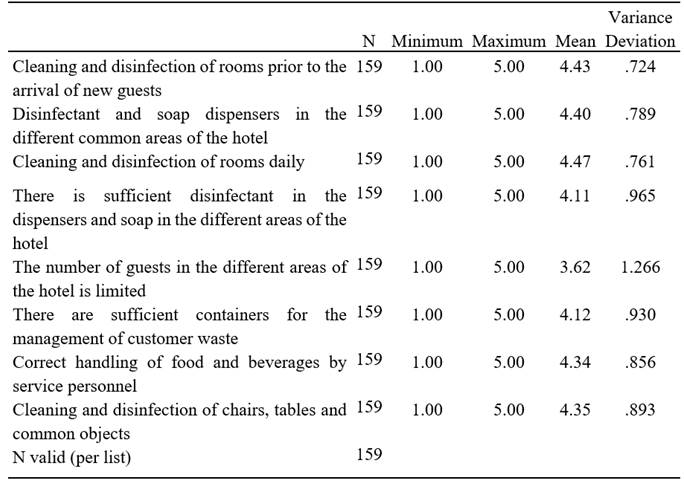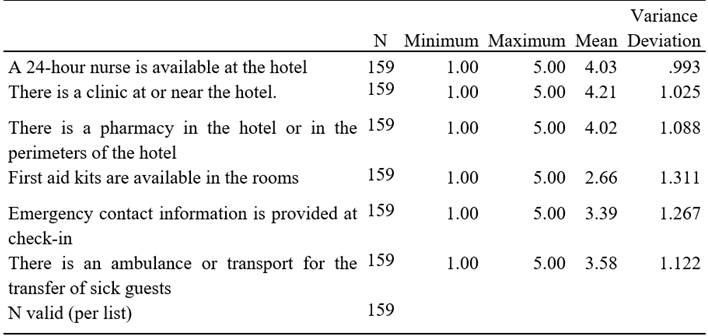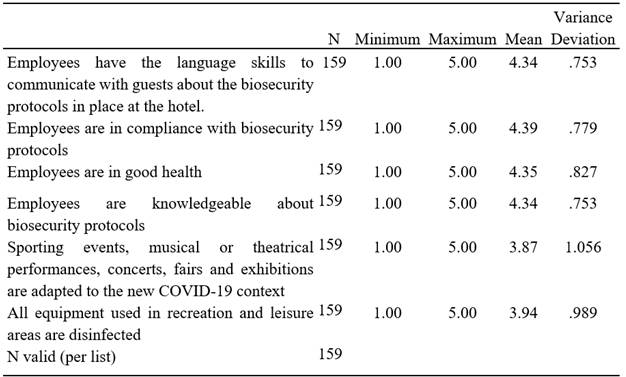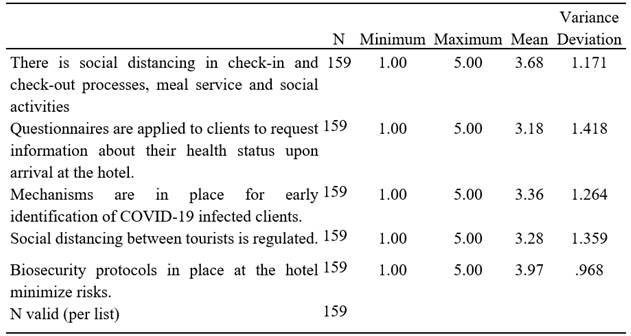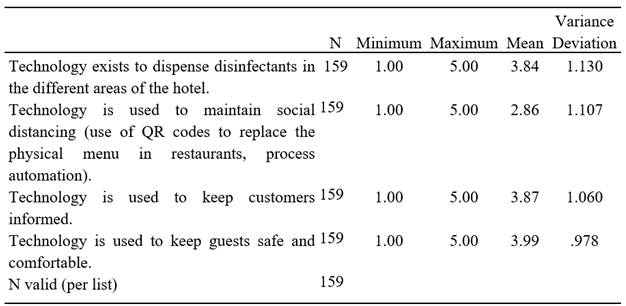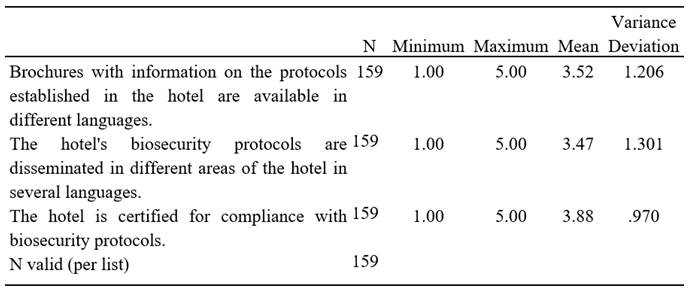Introduction
In the case of Latin America and the Caribbean, the first outbreaks occurred at the end of February 2020, which led the governments of the region to take containment measures against the virus, especially after March 11, 2020, the date on which the World Health Organization (WHO) declared the transmission of the new coronavirus as a pandemic (CEPAL, 2020).
The COVID-19 outbreak has created a new risk, forcing the world to reconsider how we live, work, think and travel. This new scenario is likely to have a lasting impact on tourism for years to come, (Villacé-Molinero et al., 2021) as tourism activity is closely linked to the mobility of people, so restoring its behavior is conditioned by the safety offered at each destination based on the redesign and sustained implementation of hygienic and sanitary practices associated with their processes and activities, in the new post-COVID-19 conditions (MINTUR, 2020).
This exposure to epidemics has an impact on the perception of the tourism consumer as a consequence of a change in the image of the destination and in the variables that are part of the decision making process, such as risk or confidence of the decision maker (Andreu et al., 2020; Garg, 2011). Understanding how travelers perceive risk is crucial to provide solutions to reduce the perceived risk (Villacé-Molinero et al., 2021) that is involved as a consequence of insecurity and that is not alien to tourists during their stay in the destination (Shin & Kang, 2020)
For the industry, it is essential to understand the new needs of travelers in this post-pandemic stage, since the services provided must be adapted to the new customer profile. Currently, two factors are beginning to be noticeable for travelers: tourist safety and cleanliness (Alam & Parveen, 2021; Shin & Kang, 2020).
Tourism safety refers to the protection of life, health, physical, psychological and economic integrity of visitors, service providers and members of the host communities, (Arroyo-Berrocal et al., 2020; Jiménez-García & Pérez-Delgado, 2018; López-Morales, 2019; Martínez & Quintana, 2019; Salas-Medina et al., 2019) considering the safety itself of the visitor, solving their problems before and during the trip and finally at the destination (Vargas-Guzmán et al., 2021).
The crisis derived from epidemics causes that within tourism safety, health safety is one of the most treated topics, (Jaime-Torre & R-Toubes, 2017) by constituting a strategy focused on eradicating or reducing risks and threats of health content, contemplating as the main objective the establishment of prevention mechanisms, as well as the need for rapid action with which to avoid and control infectious and parasitic diseases (Gallego-Hernández, 2017). Health safety measures in destinations came to be considered as the priority incentives, determinants of travel and tourism (Singerman & Makón, 2020)
To manage the crisis caused by Covid-19, hotels took measures including furloughs, hotel closures, and staff reductions, as well as implementing enhanced cancellation or rebooking policies and housekeeping protocols to provide a safe environment for employees and guests (Meng et al., 2022).
At present, the revival of tourism activity in the different countries depends on the control of the number of COVID-19 cases, progress in vaccination campaigns, proof of vaccination certificates and RT-PCR tests, as well as on the protocols established in the destinations.
In Cuba, safety in the tourism sector is part of the National Security Plan, so the reopening of tourism services was conditioned to the elimination of the risks of manifestation of the disease with epidemic characteristics and scope, (MINTUR, 2020) while maintaining certain measures to prevent a setback in the spread of the disease (Iruela-Fernández, 2020).
In the June 2022 update of the Cuban protocol for tourism services in the new normal, reference is made to the need to learn to live with the disease by ensuring the safety of customers and workers, through epidemiological surveillance, mandatory hand disinfection, daily cleaning, maintaining the application of direct surveys to customers to measure their satisfaction, among other specific measures for each tourist establishment and work areas (MINTUR, 2022; Montero-López et al., 2022) The most noteworthy aspect of this update is the opening of Cuban borders as a result of the progress made in the vaccination campaign and pandemic control.
The province of Holguín is one of the main Cuban tourist destinations and, as in the rest of the country, the development of tourist activity was affected by the current pandemic. In this province, the Pesquero pole stands out with 4 hotels and an availability of 2,867 rooms. After the reopening of tourism in the country and the established protocols, it is necessary to identify the perception of customers about the security in the pole in the new normality in order to ensure the confidence of visitors.
The need for these studies is substantiated considering that, nowadays, travelers will seek more safety measures, especially in the context of infection control and prevention (COVID-19) during the travel and post-pandemic era (Montero-López et al., 2022). Therefore, it is worthwhile to reexamine hotel industry safety management from the perspective of potential guests in the context of infection control and prevention.
In this sense, the objective of this study is to analyze the perception of national and international clients regarding the health safety implemented in the hotels located in the Pesquero pole, Holguin, Cuba. The present study is pertinent due to the lack of similar studies in the country as a tourist destination, the relevance of the tourist pole and the growing importance of health safety for the development of the tourist sector.
Methodology
The present research is quantitative and descriptive in nature, since it measures dimensions of the perception of health security of clients staying in hotels in the post Covid-19 stage. The survey was selected as the data collection instrument to be applied, since it allows flexible and rapid data collection from a larger population. For data collection, a questionnaire developed by Díaz-Pompa et al. (n/d) was adapted for the study. The questionnaire consists of six sections with thirty-two item statements related to health safety. The necessary modifications were made in the demographic section, according to the needs of the study. Cronbach's alpha coefficient was applied to test reliability; the Cronbach's alpha value was .934, which showed a high level of reliability. No major changes were made to the questionnaire.
A simple probability sample was used, ensuring that all elements of the population had the same probability of being chosen. The sample size was calculated using the expression applied to statistical sampling for finite populations, taking as the population the clients over 18 years of age staying at the hotels operating in the Pesquero destination between June 23 and July 7, 2022.
N = population= 3364
z = confidence level= 2.58 (99%)
p = probability of occurrence of the studied event= 0.5
q = probability that the studied event does not occur= 0.5
e = margin of error= 0.1 (10%)
The result was a sample of 159 people with different demographic characteristics, which allows us to homogenize a criterion in relation to the perception of health security in the post-Covid-19 stage.
The questionnaire is aimed at diagnosing the perception of tourist safety in hotels after the Covid-19 pandemic, starting with a section of informative questions regarding age, gender, travel motivation, previous visits to the hotel, and the section referring to the subject of the research with 32 aspects distributed in six dimensions: Cleanliness and hygiene, Medical assistance, Hotel staff, Prevention and mitigation, Technology and Communication with response categories in likert type scales: 1 Strongly disagree, 2 Disagree, 3 Neutral, 4 Agree and 5 Strongly agree, which allowed measuring the characteristics of clients' perception regarding health safety in the new normality stage.
From the results of the surveys, a database was created in SPSS statistical software. Descriptive statistics were used in this study to determine the frequency of aspects related to the health safety of clients in the post-pandemic stage. First, means and standard deviations are analyzed in relation to sociodemographic variables. Secondly, from a categorical perspective, the percentages are studied according to the dimensions and indicators that were taken into account in this research.
Ethical Considerations
The purpose of the survey was explained to potential participants, who were instructed to provide consent for voluntary participation. Anonymity was assured in the study to maintain the confidentiality of the participants' identity. All the procedures performed in this study involving humans were under the ethical considerations of the Helsinki declaration of 1964 and its subsequent amendments or its ethical norms.
Results
The sample consisted of 159 clients, of whom 74 (46.5%) were female and 85 (53.5%) were male. The ages of the participants ranged from 18 to 25 years 18 (11.3%), 26 to 40 years 51 (32.1%), 41 to 60 years 63 (39.6%) and over 60 years 27 (17.0%). As for the motivations for traveling to the destination, 50.9% (81) said they visited the destination for its beaches, 16.4% (26) for family and friends, 14.5% (23) for safety, 8.8% (14) for the Cuban people, 6.9% (11) for culture and heritage, and 2.5% (4) said they visited the destination for health reasons.
Customers' perceptions of the dimensions studied are as follows:
Cleanliness and hygiene
In the post-pandemic stage, the importance of cleanliness and hygiene is emphasized as a key factor in the health safety of tourists. The findings in Table 1 indicated that clients perceived this dimension positively, with very high scores (strongly agree and agree). More than 3/4 of the respondents (89.3%) recognized the quality of cleanliness and disinfection of the rooms every day (M = 4.47, SD = .761). Almost all respondents (90.5%) confirmed that they were satisfied with the general cleaning and disinfection of the rooms before the arrival of new guests (M = 4.43, SD = .724), as well as with the existence of disinfectant and soap dispensers in the different common areas of the hotel, cleaning and disinfection of chairs, tables and common objects, correct handling of food and beverages by service personnel, existence of sufficient containers for the management of guest waste, and the existence of sufficient disinfectant in the dispensers and soap in the different areas of the hotel were evaluated positively. On the other hand, although 58.4% of respondents considered that the number of guests in the different areas of the hotel was limited, 20.8% considered that these areas were not well delimited.
Medical assistance
The findings regarding medical assistance show in Table 2 that clients perceive very positively the existence of a clinic in or near the hotel (M = 4.21, SD = 1.025) as well as having 24-hour health specialists (doctor and nurse) in the hotel (M = 4.03, SD = .993) and having a pharmacy in the hotel or in the hotel perimeter (M = 4.02, SD = 1.088). However, although there is a positive perception of the existence of ambulances or transportation for the transfer of clients in case of emergencies (47.1%), 41.5% assume a neutral position. In this dimension, the item least valued by guests is the existence of a first aid kit in the rooms (45.3%).
Hotel Staff
The clients rated as very positive the hotel staff's compliance with biosecurity protocols (M = 4.39, SD = ,779), the good health of the employees (M = 4.35, SD = ,827) and their knowledge of biosecurity protocols (M = 4.34, SD = ,753). More than half of the respondents 69.8% validated the ability of the hotel staff to generate sporting events, musical or theatrical performances, concerts, fairs and exhibitions adapted to the new post-Covid-19 context, likewise 66.6% valued by the employees the disinfection of the means used in the recreation and leisure areas. Language proficiency is an indicator of success in communicating with clients about the biosecurity protocols established in the hotel (M = 2.30, SD = 1.348).
Prevention and mitigation
Table 5 shows the results concerning the prevention and mitigation of covid-19 within the hotel facilities, the clients positively recognize 72.3% that the biosecurity protocols manage to minimize the risks in the hotel (M = 3.97, SD = ,968), 63.5% appreciate that in the check-in and check-out processes, 63.5% were not satisfied with the existence of mechanisms for the early identification of clients infected with covid-19 (M = 3.36, SD = 1.264), 25% were not satisfied with this procedure (M = 3.36, SD = 1.264).
Technology
The findings found regarding the use of technology to provide greater security to customers in hotel facilities, 75.5% of respondents refer that there are technologies to provide security and comfort to customers (M = 3.99, SD = ,978), 72.3% agree that there are technologies to keep customers informed about the elements concerning the safety of the health of customers (M = 3, 87, SD = 1.060), more than half of them state that there is enough technology to dispense disinfectants in the hotel areas, on the other hand, there is a negative perception regarding the use of QR and other technologies that reduce contact with customers (M = 2.86, SD = 1.107).
Communication
Tourism industry professionals confirm how important communication is for tourists to have more positive experiences and to understand the distinctive elements related to safety at the destination. More than half of the respondents stated that one of the aspects that the hotel communicates well is the certification of compliance with biosafety protocols (M = 3.88, SD = ,970), 55.3% stated that information on the protocols established in the hotels is provided in different languages (M = 3.52, SD = 1.206) and 54.7% agreed that the biosafety protocols established in the hotel areas are disseminated in different languages (M = 3.52, SD = 1.206).
Discussion
In the post-pandemic context, travel motivations continue to be a key factor in the decision-making process of consumers to visit a tourist destination (Carvache-Franco, et al., 2022). The exploration of the main motivations for visiting the Pesquero Pole in Holguín shows that for more than 50% of those surveyed, beaches are the main attraction or travel motivation, followed by meeting with family and friends and tourist safety in third place. The results obtained are consistent with those of Carvache-Franco, et al., (2022), the main findings of this research reveal that safety in the destination and safety in service are the third and fourth motivations for visiting the coastal cities of Lima. Undoubtedly, safety has nowadays become a key factor in the selection of a destination and even in the choice of a hotel, Robina-Ramirez et al., 2022. These results force destination and hotel managers to make more efficient use of resources and implement strategies that differentiate them from the competition.
The clients' perception of the cleanliness and hygiene of the hotels in the Pesquero sector is very positive. The daily cleaning and disinfection of the rooms, the general disinfection of the rooms before the arrival of new clients, the existence of sufficient disinfectants and soaps in the different areas of the hotel, the disinfection of tables, chairs and common objects, the correct handling of food and beverages, as well as the correct management of waste and residues are all favored. These findings are consistent with those of Montero-López et al., (2022) who found in the perception of national clients in the hotels of Guardalavaca in the Holguín destination, very positive results regarding this factor. Cleanliness and hygiene in the current revitalization of tourism in the Pesquero pole plays a fundamental role in making customers feel safe during their vacations. Where hygiene and cleanliness used to be an overlooked factor for tourism destinations, nowadays these factors are of interest to travelers when making their travel related decisions, in such sense, it is suggested that hygiene and cleanliness should be the focus of attention when estimating the recovery of the accommodation industry in the post-COVID-19 stage, (Atadil & Lu, 2021). However, in this dimension it requires special attention to limit the number of customers by the different areas of the hotel, as this was the most affected indicator.
In the same sense, preceding research such as Ghazi (2016) found that medical assistance is the second most important dimension for customers after room safety with respect to a hotel's safety and security measures. At present times, medical assistance constitutes a factor that with covid-19 customers have provided significant importance. The findings of the present research show a high degree of customer satisfaction with the existence of a clinic in the hotel or in its perimeters, as well as having the service of a doctor and nurse 24 hours a day and having the services of a pharmacy. These elements, according to Ghazi (2016) in his research refers that they are very important for hotel guests. Similarly, these results are consistent with those of Montero-López et al., (2022), which evidences that the policy followed by tourism managers in Cuba regarding medical assistance in tourism is essential to ensure the safety of customers. On the other hand, although there is a positive perception regarding the information offered on emergency contacts in the check-in process and the existence of ambulance or transport for the transfer of sick clients, in both cases there is a large percentage of clients who assume a neutral position, in this sense it is considered that clients require more information regarding these elements.
Having a staff with competencies to face the new challenges facing the hotel industry today is a great challenge (Joshi & Sadhale, 2022). However, to ensure safety in the Cuban hotel sector since the emergence of Covid-19, work has been done to train tourism professionals to master the mechanisms for the development of sustainable tourism projects, who have the ability to identify the social and environmental effects linked to the sector and know how to apply them Montero-López et al., (2022). This has allowed the hotel sector to have a professional capable of adapting to new circumstances, maintaining continuous learning in addition to practicing critical analysis of information, focusing on problem solving. The findings of the present research, based on what clients perceive, corroborate this. More than – of the clients positively acknowledge employees' compliance with biosafety protocols, the health status of each employee, and their knowledge of biosafety protocols, and the language skills of the hotel employees to be able to communicate effectively with clients in terms of providing information on the biosafety protocols established in the destination and specifically in the hotel; on the other hand, clients recognize the creative capacity of the hotel staff to create sporting events, musical or theatrical performances, concerts, fairs and exhibitions adapted to the new context of COVID-19. According to Delgado & M.A.P., (2018) in terms of security it is about adapting these elements to the type of culture where the clients come from, taking into account, customs, language, among other factors, contrary to this, the effects can be adverse compromising the security and the choice of the destination.
According to Dwiatmojo et al. (2021), the correct implementation of health protocols by tourist destinations and hotels can be used as an important option in strategies to attract tourists to the destination. In this sense, Kaniasari et al., (2021) refer that the incorporation and compliance with Health Protocols in the services provided by the hotel, ensures safety and comfort for customers during their stay in the facility. The findings of this research show that almost – of the clients positively recognize the effectiveness of the biosecurity protocols; these results are consistent with Kaniasari et al. (2021) who in their research on the effectiveness of the health protocols found that their implementation strengthens tourism safety and thus the prevention of infections, while increasing satisfaction by 25%. On the other hand, a little more than 50% of clients report feeling satisfied with the control of social distancing in the check-in and check-out processes, catering services and social activities. With regard to the request for information on the state of health of clients upon arrival at the hotel, only 48.4% were satisfied, as were the mechanisms that should be in place for the early identification of clients infected with Covid-19. Not feeling completely satisfied with these aspects urges hotel managers to incorporate in their management the control of these aspects for greater safety of customers visiting the facility or the incorporation of technological innovations. Even though the efforts of the Cuban State, the Ministry of Health and the Ministry of Tourism are evident, where sanitary protocols are rigorously applied and all the facilities have been adapted to respect the social distancing measures, in such a way that they have managed to certify to respect these measures. For outstanding compliance with the established hygienic-sanitary and safety protocols, Cuba was awarded last year the Tourism + Hygienic and Safe (T + HS) Certificate (Montero-López et al., 2022). On the other hand, Cuba has 93% of the population with a complete vaccination schedule, which allows a higher degree of protection in case of infection of the virus and a greater reduction of serious cases, enabling improvements for the circulation and development of tourism activities in the territory, standing out as one of the safest destinations in Latin America and the Caribbean.
Technological innovation plays a key role in the recovery of the hospitality industry, (Atadil, & Lu, 2021). They provide significant opportunities to mitigate the negative impacts of epidemics. If these cannot eliminate the risks completely, they can mitigate their consequences, (Ivanov et al., 2022). However, the false belief that the hospitality industry is slow to use service innovations with technology because of a lack of knowledge, skills, confidence and potential risks must be dispelled (Meng et al., 2022). Service innovations involving technologies can create value and efficiency, on the one hand, it contributes to customer safety and on the other hand, it contributes to better hotel management. The results of the present research corroborate this, 75. The results of the present investigation corroborate this, 75.5% give a positive evaluation on the existence of technology to provide safety and comfort to the clients in the facilities, likewise almost – of the respondents recognize that there is enough technology to keep the clients informed about everything concerning the health safety of the clients, likewise, more than half find the number of disinfectant dispensers in the different areas of the hotel sufficient to ensure the disinfection of the clients' hands, one of the fundamental measures for the health safety of the clients. However, there is a negative result regarding the use of technologies to ensure social distancing among guests. In such a sense, hotels can use innovative technologies to provide contactless service to attract more customers and reduce perceived health risks (Meng et al., 2022) (Ivanov et al., 2022). Therefore, the availability of self-service technologies (e.g., a self-service technology for check-in and check-out or the use of QR code) can make a difference in the decision making process of customers, (Meng et al., 2022).
Last, but not least, is the communication factor. In various investigations, depending on the context and the clients, the level of importance of this factor varies, however, for Atadil, & Lu, (2021) it is the second most important predictor of future hotel selection behaviors. After the impact of Covid-19 and in the stage of tourism recovery, the importance of communication between hotels and clients is recognized, taking into account that this is fundamental to make known the different policies or protocols implemented by the different countries, as well as in the control and prevention of infectious diseases, (Atadil, & Lu, 2021). In the present investigation, the results show a positive perception according to the communication factor, more than half of the clients refer that the hotels of the fishing pole in their communication strategy have included publicizing the certification of the hotels for compliance with health safety measures (Tourism + Hygienic and Safe (T + HS) Certificate), information is provided on the biosecurity protocols established in the hotels in different languages and formats (brochures, short documents and information posters) likewise, the sanitary measures are disclosed in the different areas of the hotel in different languages. However, the researchers of this research consider that hotel communication can be enhanced based on the potential they have to carry it out. In this sense, we agree with Atadil, & Lu, (2021) who refer that an accurate and sufficient communication can have two advantages: on the one hand, it helps customers to know the hotel better with respect to the protocols implemented and, on the other hand, perhaps most importantly, it helps hotels to know their customers better, such as their personal travel history. and health status. Finally, successful health communication will allow customers to perceive more safety and security benefits and less risk, and such a strategy will improve customer confidence in the selected hotel.
Conclusions
The rapid spread of Covid-19 worldwide and the risks brought about by this virus had a strong impact on tourism. The rapid reactivation of this activity in the new normality depends on effective security and protection systems that guarantee the control and prevention of infections, as well as the life of customers. Tourism safety is a multidimensional phenomenon of prevention and attention to visitors, and therefore includes tourists, service providers and the local community. Undoubtedly, it is necessary to increase scientific research in this area in order to know its effectiveness. Customer perception studies create a tool that can help industry managers to raise safety and hygiene standards and thus gain the acceptance and confidence of potential hotel guests in their services.
The use of the questionnaire in this study allowed, through six factors and their respective indicators, the analysis of the perception of national and international clients regarding the sanitary safety implemented in the hotels located in the Pesquero pole, Holguín, Cuba in the post-pandemic stage, to analyze the results by indicators and dimensions, as well as to identify the elements that constitute barriers or affect the image as a safe hotel.
Among the main findings are that safety is one of the main motivations for tourists to visit the destination. Regarding the factors studied, in general, there is a positive perception of the health safety of the clients in the hotels of the Pesquero pole. At the level of factors, cleanliness and hygiene, medical assistance and hotel staff were the most valued by clients, while prevention and mitigation, technology and communication, although showing positive results, achieved lower scores compared to the rest. In terms of indicators, social distancing is the most affected, as well as the use of innovations to guarantee this and the exercise of good communication with clients regarding the biosecurity protocols implemented in the destination and fundamentally in the hotel. In this sense, it is considered appropriate to introduce some innovations of contactless service (automation of check-in and check-out, use of QR, among others) that will ensure social distancing within the facility.
Finally, Holguín, Cuba, stands out for its natural, cultural and heritage attractions, among others, but its beautiful beaches are its main attraction, in addition to the health safety of visitors. Safety factors become one of the vital aspects to provide more quality in tourism, improve the image of destinations and achieve customer satisfaction with services. Knowing the perception of tourists regarding risks and real factors that affect safety is essential for all entities that provide services to the tourism sector, taking into account that the image of a safe hotel has become a valuable asset from the perspective of customers in the new normality. In this sense, these elements contribute to differentiate from the competition, so it is considered that they should be included in the promotional strategies of the destination.














